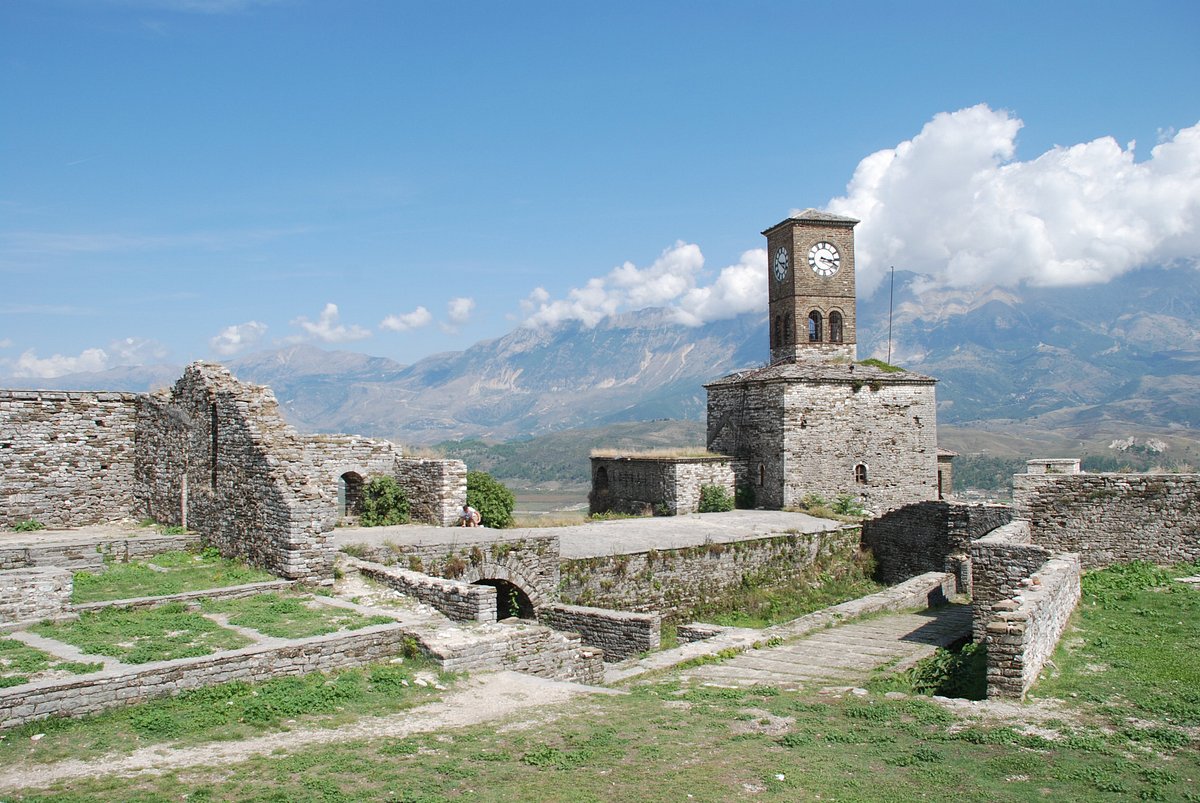
Deep within Albania, amidst the lush green hills of the Drino valley, Gjirokastër stands as an architectural and historical gem, recognized as a UNESCO World Heritage site. Known as the "Stone City," Gjirokastër captivates visitors with its characteristic gray stone houses, winding cobblestone streets, and a majestic fortress perched atop a hill. This article will take you on a journey to discover Gjirokastër, from its historical context and distinctive architectural and cultural features, to detailed guidance on transportation, accommodation, and estimated costs for your trip.
Gjirokastër (Albanian: Gjirokastra) is an ancient city located in southern Albania, within the Gjirokastër County. With a modest population of approximately 28,673 (2011 municipal data), the city is like a living museum, where time seems to stand still. Gjirokastër is strategically situated between the lowlands of western Albania and the inland plateau, offering a typical Mediterranean climate with hot summers and relatively high rainfall compared to other regions in the area.
The unique charm of Gjirokastër lies in the perfect blend of Ottoman architecture and majestic mountainous landscapes. Unlike many other tourist destinations that embrace modernization, Gjirokastër largely preserves its ancient beauty. The houses, built from gray stone with slate roofs and intricately carved wooden balconies, create a uniform, harmonious, and captivating image when viewed from afar, seemingly a natural extension of the hills they cling to. This is not just a place to sightsee, but an authentic experience, transporting visitors back to a glorious past, allowing them to feel the pulse of Albanian history and culture.
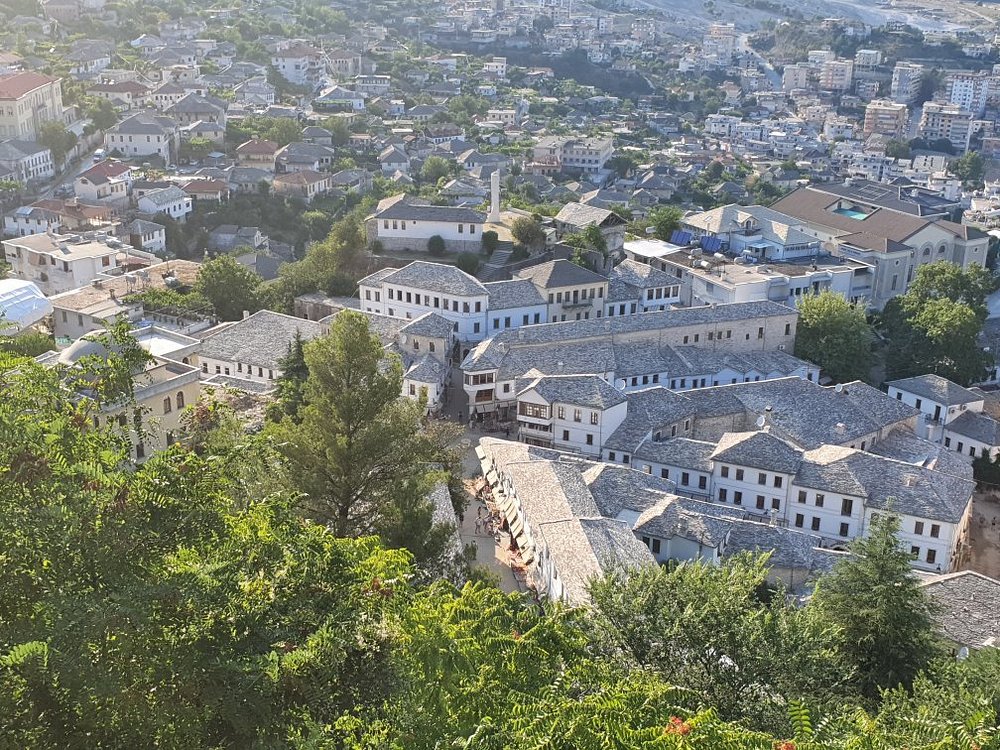
Gjirokastër is an open-air museum, where every alley and every house tells a story. Visitors will find countless attractions and activities to immerse themselves in the beauty and history of this place.
Gjirokastër Castle: Dominating the hilltop, this magnificent fortress is the heart and soul of the city. It is one of the largest and best-preserved castles in Albania, with a history dating back to antiquity and significantly expanded during the Ottoman era. Inside the castle, you will find:
National Museum of Armaments: Showcasing an impressive collection of weapons from ancient times to World War II, including a surprising US Air Force plane that crashed during the Cold War.
Communist-era Prison: A part of the castle once served as a prison during the communist period, offering a raw glimpse into a difficult historical phase for Albania.
Clock Tower: An icon of the castle, from here you can enjoy panoramic views of the stone city below and the vast Drino valley.
National Folk Festival Stage: Every five years, this open-air stage hosts the Albanian National Folk Festival, a grand event celebrating traditional music, dance, and costumes.
Ethnographic Museum: Housed in the former home of the late communist leader Enver Hoxha, this museum is a prime example of 19th-century traditional Gjirokastër house architecture. The museum displays household items, costumes, tools, and handicrafts, helping visitors understand the daily life, customs, and practices of the local people throughout various periods.
Skenduli House: One of the best-preserved Ottoman houses in Gjirokastër, built in the early 18th century. Skenduli House stands out with its distinctive architecture, spacious living rooms, intricately carved wooden balconies, and unique defensive features. The Skenduli family still owns and manages this house, often personally guiding visitors and sharing fascinating stories about their family history and the house's architecture.
Zekate House: Built in 1811-1812, Zekate House is considered one of the most magnificent examples of tower house architecture in Gjirokastër. With its twin towers and multiple floors, this house once belonged to a wealthy aristocratic family. The climb up may be a bit strenuous, but the views and interior architecture will certainly delight you.
Old Bazaar: This was the commercial and social center of Gjirokastër for centuries under Ottoman rule. The old bazaar is a labyrinth of cobblestone streets where visitors can find shops selling local handicrafts such as silverwork, woolens, carved wood, and traditional cafes. Although restored after numerous damages, the bazaar still retains its bustling and ancient atmosphere.
Blue Eye Spring (Syri i Kaltër): Although not located directly in Gjirokastër but about an hour's drive away (near Sarandë), the "Blue Eye" is an unmissable natural wonder when visiting southern Albania. It is a deep, crystal-clear freshwater spring of astonishing turquoise color, where water bubbles up from the earth to form a vivid "pupil." Surrounded by lush green forest, it creates an ethereal and refreshing setting.
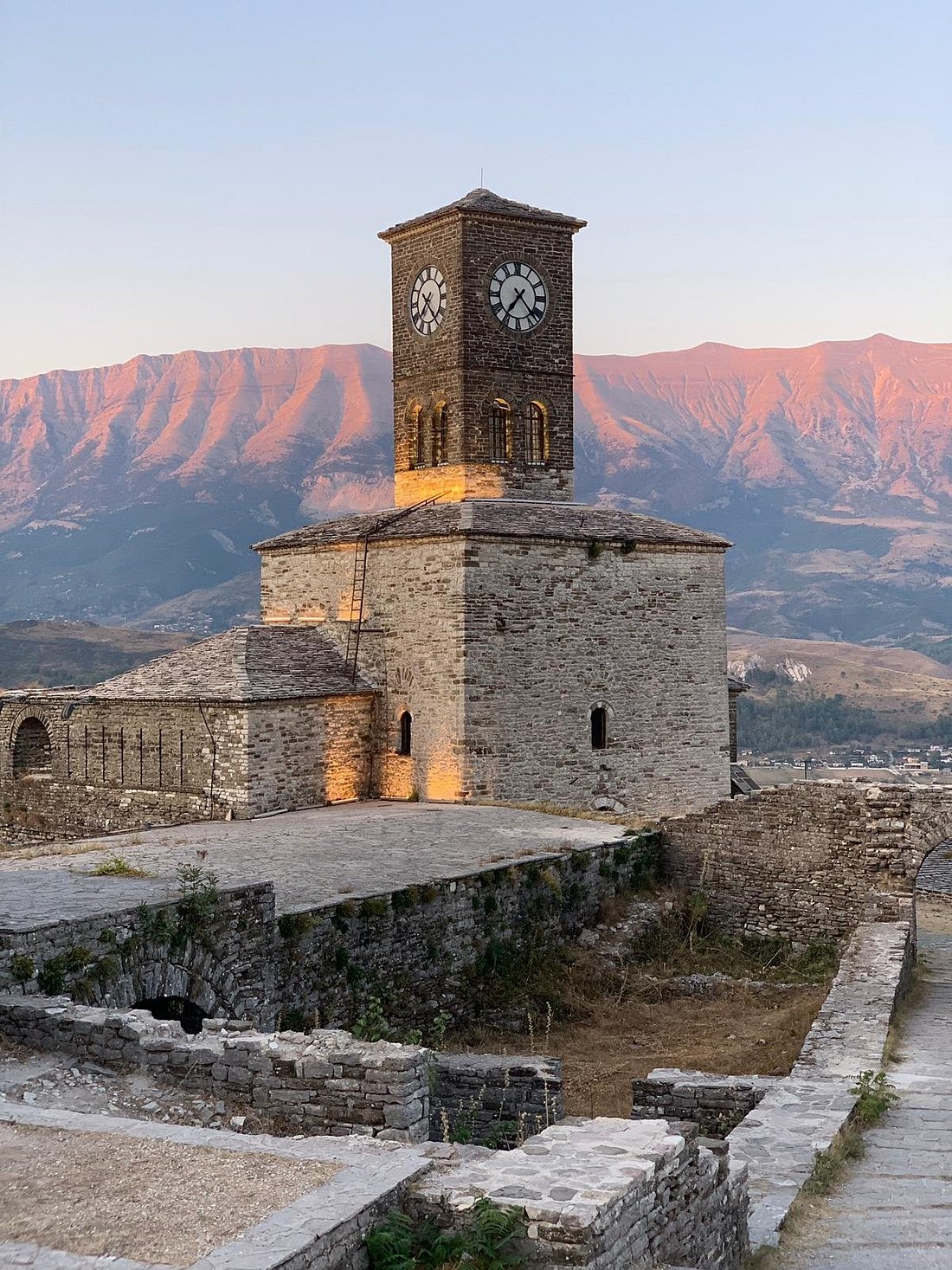
Walking Tour to explore the city: The best way to experience Gjirokastër is to wander through its steep, cobblestone streets. Every nook and cranny might reveal an interesting architectural detail or a cozy cafe. Be sure to wear comfortable shoes as the streets can be slippery and steep.
Explore the Cold War tunnel: Hidden beneath the city, this is a vast system of tunnels built during Enver Hoxha's communist regime to protect officials in case of nuclear war. A tour of the tunnels offers deep insight into Albania's anxieties and preparations during that period.
Hiking to Ali Pasha Bridge: This ancient stone bridge is often considered part of the Ottoman-era aqueduct system. The hiking trail to the bridge is quite beautiful, passing through peaceful rural landscapes and offering excellent photo opportunities.
Experience Gjirokastër wood carving: Some local artisans in the old bazaar district still practice traditional wood carving. Visitors can participate in small workshops to learn about this technique and create unique souvenirs by hand.
Enjoy traditional coffee at the Old Bazaar: Sitting at one of the small cafes in the old bazaar, sipping a strong traditional Turkish coffee, and watching life unfold around you is an essential experience. This is a great place to relax and feel the slow pace of Gjirokastër's life.
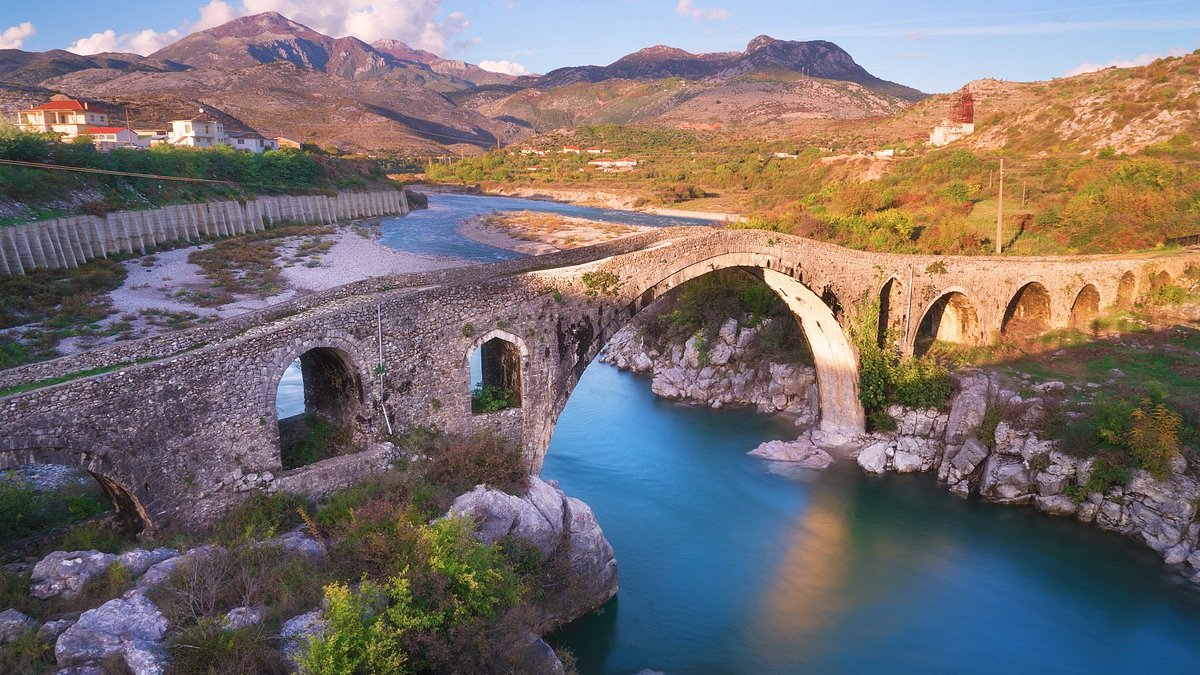
Attend the National Folk Festival (if applicable): If you are lucky enough to visit Gjirokastër during this festival (held every five years), you will witness a spectacular display of folk music, dance, and costumes from all over Albania.
Interact with local families: Some traditional houses like Skenduli House are still managed by the descendants of the original owners. They are often very open and willing to share their stories and customs with visitors, providing an authentic glimpse into life in Gjirokastër.
Shop for handicrafts: Visit the shops in the Old Bazaar to purchase unique handicrafts such as silverwork, hand-woven carpets, carved wood, and wool products. These are not just souvenirs but also a way to support local artisans and preserve traditional crafts.
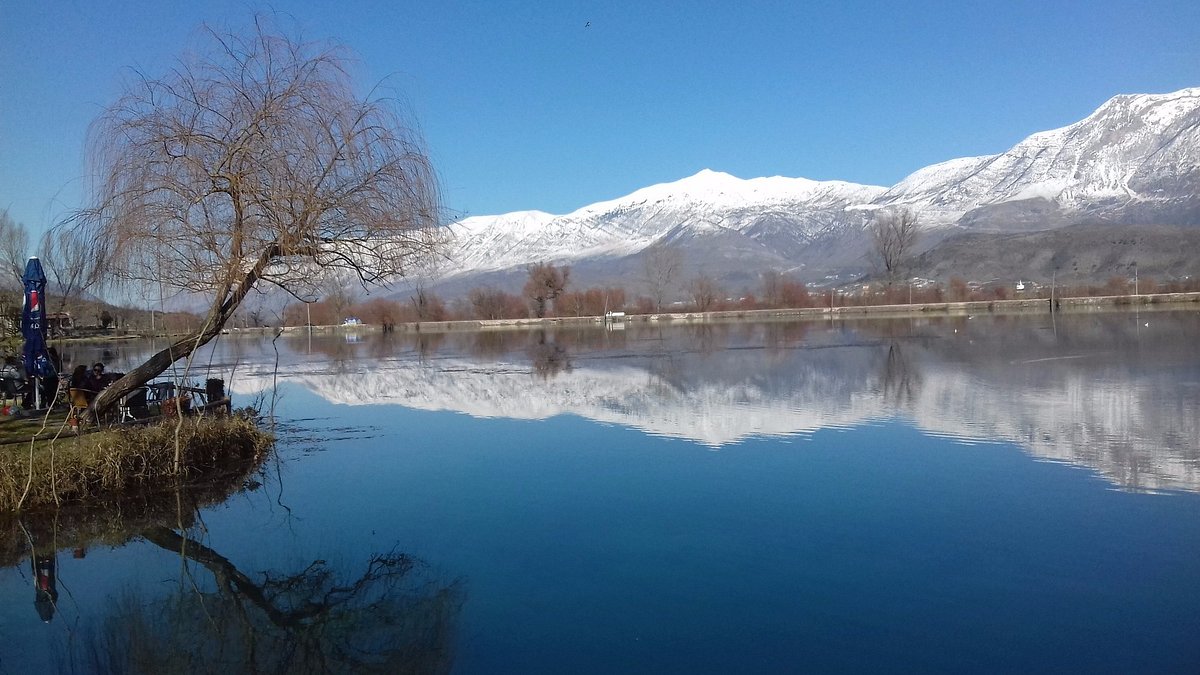
The culture and lifestyle in Gjirokastër are a harmonious blend of Ottoman heritage and resilient Albanian spirit. The rugged geography and long history have shaped a community with a strong identity.
Distinctive stone architecture ("Stone City"): This is the most prominent cultural feature. The gray stone houses, with their slate roofs, arched windows, and wooden balconies, are not only beautiful but also demonstrate adaptation to the environment. Stone is the primary building material, durable and well-insulated, keeping homes cool in summer and warm in winter. This architecture reflects the city's prosperity during the Ottoman era when Gjirokastër was an important commercial and administrative center.
Hospitality (Besa): Albanians in general, and the people of Gjirokastër in particular, are known for their hospitality. The concept of "Besa" (pledge of honor) is a core value, demonstrating loyalty, respect, and absolute hospitality. Visitors are often warmly welcomed, even invited into homes for meals or conversation. Don't be surprised if you receive enthusiastic help from locals when needed.
Language and heritage: Albanian is the main language, but since Gjirokastër is located near the Greek border and has a significant Greek community, you might hear Greek in some areas. Its multicultural history (Roman, Byzantine, Ottoman) has left a deep mark on the language, cuisine, and customs. The city is also the birthplace of important literary figures like Ismail Kadare, who vividly portrayed Gjirokastër in his works, helping the world understand more about Albanian culture.
Traditional crafts: Gjirokastër preserves traditional crafts such as wood carving, silverwork, carpet weaving, and woolen production. These skills have been passed down from generation to generation, creating unique products that bear the imprint of local culture. Strolling through the Old Bazaar and visiting artisan workshops is a great way to witness talented craftsmen at work and purchase meaningful souvenirs.
Cuisine as part of culture: Cuisine in Gjirokastër is not just food but also part of its identity. Traditional dishes are often prepared from fresh, locally sourced ingredients, reflecting the close ties to the land and agriculture. Meals are often occasions for family and friends to gather, demonstrating warmth and community bonding.
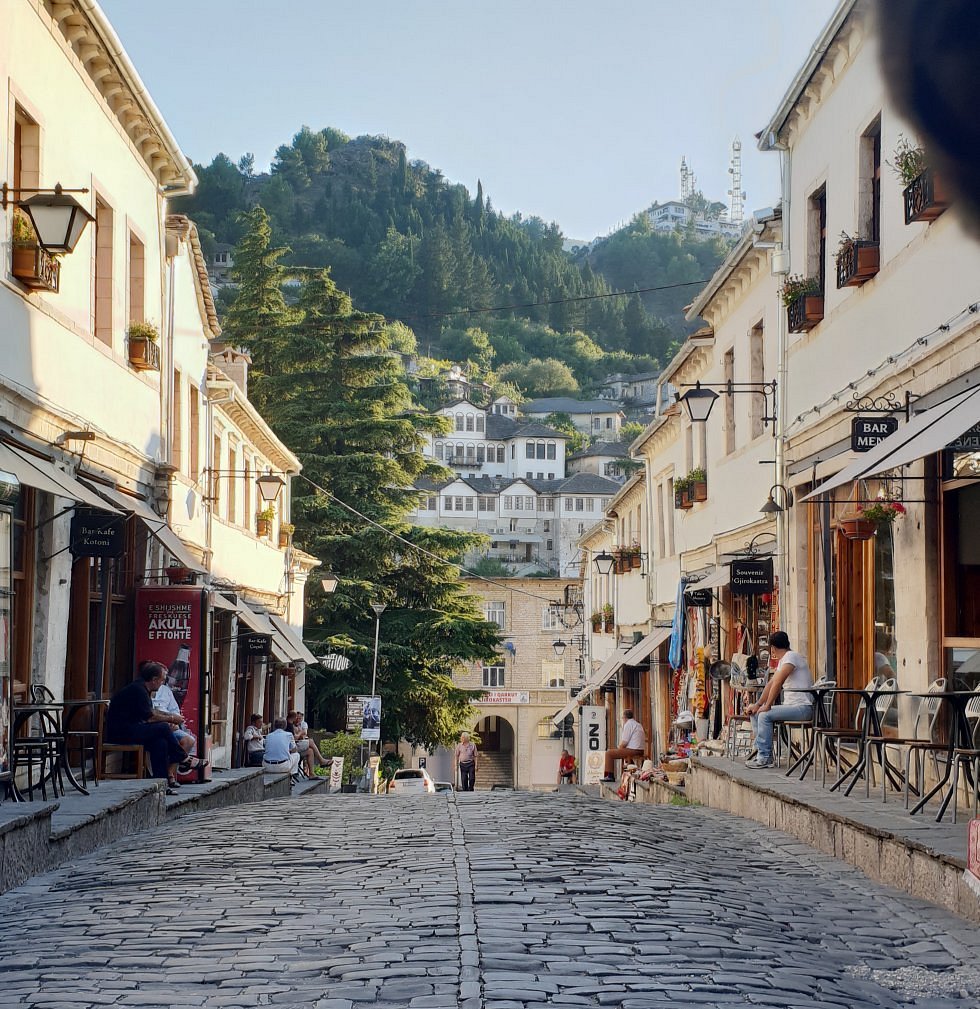
Gjirokastër's cuisine reflects its rich history and geographical location, with a blend of Balkan, Mediterranean, and Ottoman flavors. Dishes are often simple yet full of flavor, prepared from fresh local ingredients.
Qifqi: This is the iconic dish of Gjirokastër and a must-try. Qifqi are small rice balls, usually mixed with egg, fresh mint, black pepper, and a touch of salt, then fried in a special pan with circular molds. The exterior is lightly crispy, while the inside is soft and chewy, with a fragrant minty flavor. This dish is often served as an appetizer or light snack.
Tavë Kosi: Although popular throughout Albania, the Gjirokastër version of Tavë Kosi is well worth trying. This is a dish of baked lamb or goat meat with yogurt and eggs, forming a rich, creamy crust on the outside and tender, juicy meat inside. The slight tartness of the yogurt helps balance the richness of the meat. This dish is usually baked in a traditional clay pot.
Fërgesë: Another hearty dish, Fërgesë is a combination of bell peppers, tomatoes, ricotta cheese (or cottage cheese), and sometimes meat (usually beef or liver). All are stewed until tender and often served with bread for dipping. This dish has a rich, slightly tangy, and creamy flavor.
Byrek: A savory baked pastry popular throughout the Balkans, Byrek in Gjirokastër is also highly favored. The pastry has a thin, crispy crust, and the filling can be cheese, minced meat, spinach, or pumpkin. Byrek is often eaten for breakfast or as a light snack.
Imam Bajaldi: This Ottoman-originated dish consists of eggplants stuffed with a mixture of tomatoes, onions, garlic, and herbs, then baked until tender and sweet. This dish is usually served cold or at room temperature.
Oshaf: This is a traditional Gjirokastër dessert. Oshaf is a type of pudding made from sheep's milk, sugar, and dried figs, often topped with a sprinkle of cinnamon. It has a sweet, creamy, and very pleasant flavor.
Baklava and Revani: Sweet desserts of Turkish origin like Baklava (multi-layered pastry with nuts and sugar syrup) and Revani (semolina cake soaked in syrup) are also very popular, often enjoyed with strong Turkish coffee.
Local ingredients: Gjirokastër cuisine emphasizes fresh, locally grown ingredients such as tomatoes, bell peppers, eggplants, fresh herbs (mint, oregano), lamb, goat meat, and sheep/goat cheese. Olive oil is also an essential ingredient in many dishes.
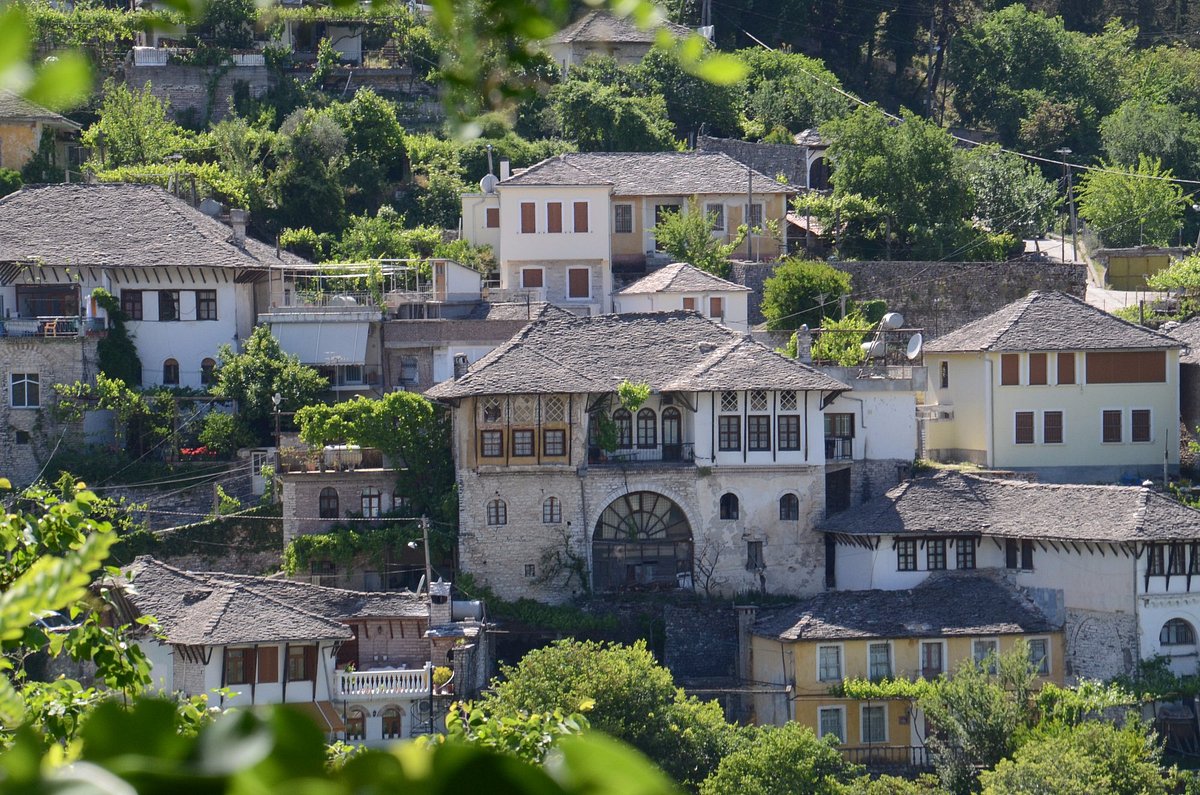
Restaurant Tradicional Odaja: Known for its cozy atmosphere and traditional dishes prepared according to family recipes. This is a great place to try Qifqi and Tavë Kosi in an authentic Gjirokastër setting. They also offer vegetarian options.
Taverna Kuka: Located on a hillside with stunning views of the city, Taverna Kuka serves traditional cuisine with a modern twist, using fresh local ingredients. The ambiance is warm and friendly.
Kujtimi Restaurant: A highly-rated restaurant, especially for its lamb Tavë Kosi. They also offer mixed platters of local dishes so you can try various flavors at once. The restaurant's terrace is an ideal spot for dining and watching life unfold in the pedestrian zone below.
Te Kalaja Restaurant & Rooms: Situated near the castle, this family-run restaurant offers ancient Gjirokastër recipes in a cozy setting, with beautiful city views.
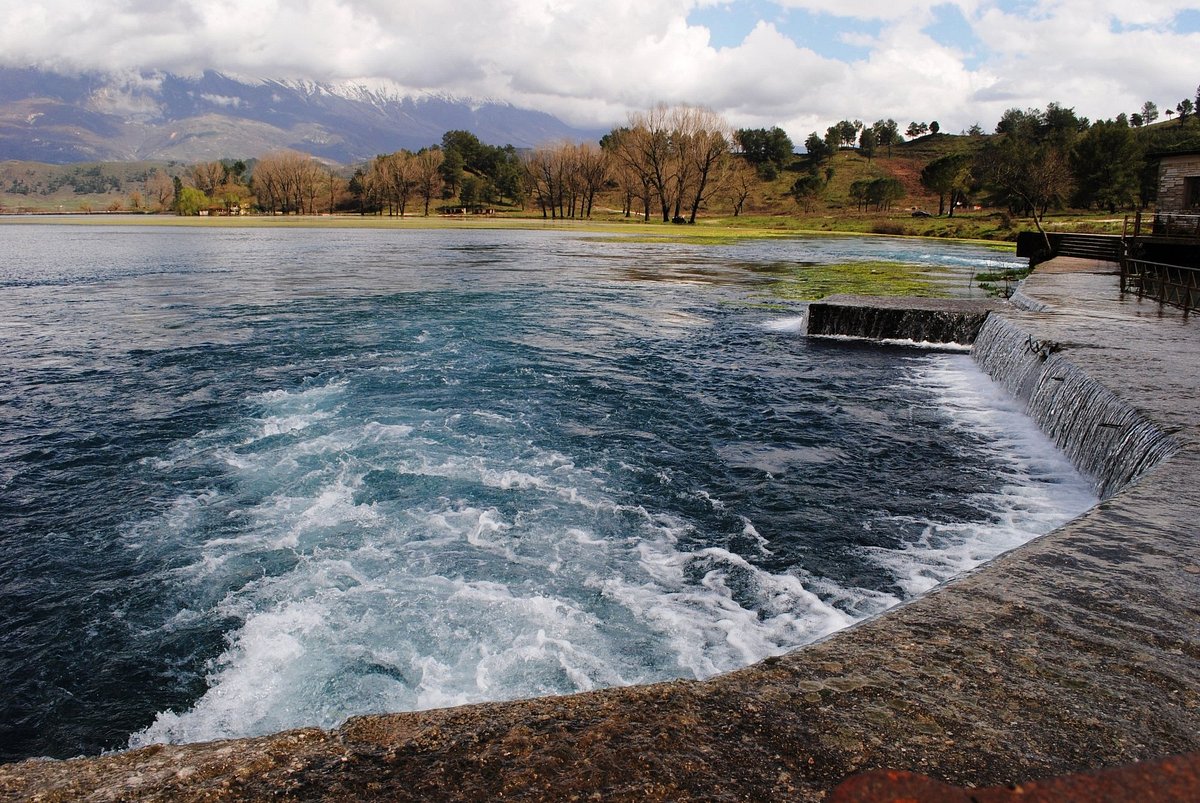
Cost: Dining in Gjirokastër is relatively affordable compared to major Western European cities. A meal at a mid-range restaurant can range from 8 EUR - 20 EUR for a main course.
Cash: While some larger restaurants accept cards, many small eateries and local markets only accept cash (Albanian Lek - ALL or Euro). Always carry some cash with you.
Try Turkish coffee: This is an indispensable cultural element. Enjoying a strong cup of coffee in a traditional cafe is a great way to relax.
Explore local markets: Visit farmers' markets to buy fresh fruits, vegetables, cheese, and other local products at affordable prices.
Gjirokastër does not have its own airport, so you will need to fly to nearby cities and then travel by road.
Main airport: Tirana International Airport Nënë Tereza (TIA) is the largest and only airport in Albania serving international flights.
From Tirana to Gjirokastër: After arriving in Tirana, you can travel by bus, taxi, or rental car.
Bus: This is the most popular and economical option. Buses depart from Tirana's bus station to Gjirokastër frequently throughout the day.
Travel time: Approximately 4 hours.
Cost: Around 12 EUR one-way. You should carry cash (EUR or Albanian Lek) as online booking is not available.
Taxi: Faster and more convenient but more expensive.
Travel time: Approximately 3.5 - 4 hours.
Cost: Around 120 - 150 EUR one-way.
Rental car: Offers maximum flexibility.
Travel time: Approximately 3.5 - 4 hours.
Cost: Refer to the car rental section below.
From Corfu (Greece) to Gjirokastër: If you are in Greece, you can fly to Corfu Island, then take a ferry to Sarandë (Albania), and from Sarandë, take a bus or taxi to Gjirokastër.
Corfu - Sarandë Ferry: Approximately 30 minutes - 1.5 hours depending on the ferry type. Cost around 20 - 30 EUR.
Sarandë - Gjirokastër Bus: Approximately 1 hour. Cost around 3.5 EUR.
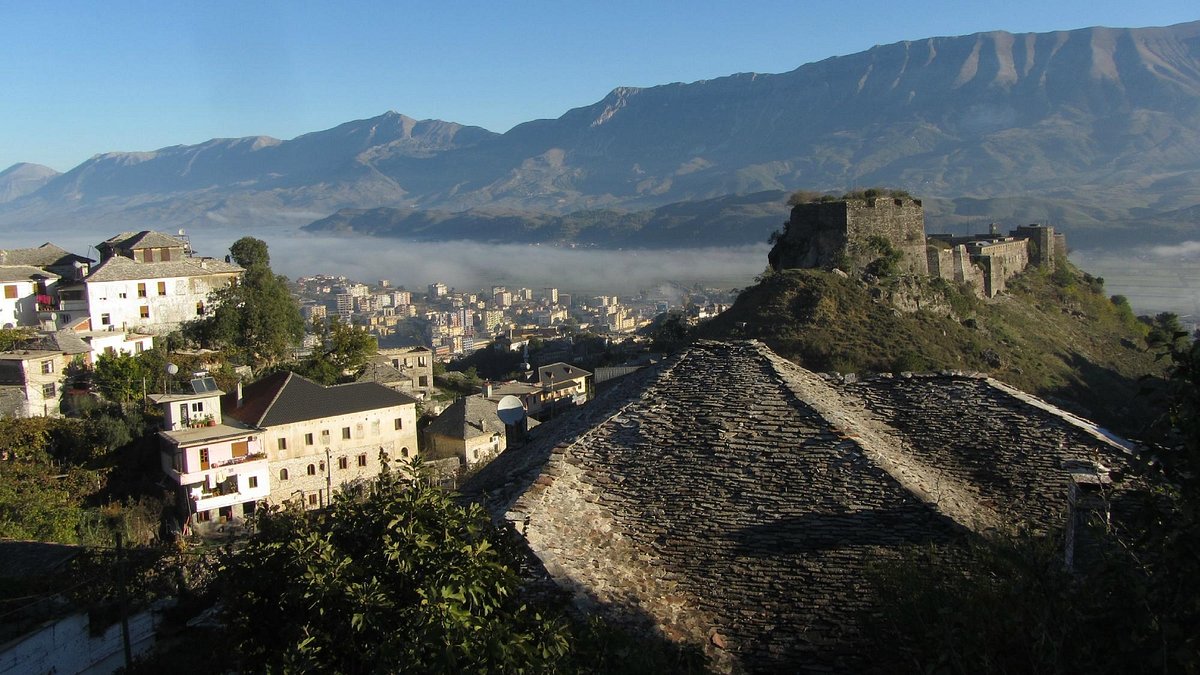
The city of Gjirokastër, especially the Old Town and Old Bazaar areas, is ideal for exploring on foot. However, due to the steep terrain and slippery cobblestone streets, you need to wear appropriate footwear.
Walking: This is the primary means of exploring the Old Town, museums, and the castle.
Taxi: Available in central areas. Taxis can take you to higher parts of the city or further destinations like the Blue Eye Spring. Negotiate the price before starting your trip.
Cost: Within the city, a short ride might be around 3 - 5 EUR. To the Blue Eye Spring, it could be about 35 - 45 EUR one-way from Sarandë (from Gjirokastër, it would be similar or slightly more).
Rental Car: If you want to explore the surroundings of Gjirokastër or travel between cities in Albania flexibly, renting a car is a good option.
Cost: From 25 EUR - 50 EUR/day, depending on the car type and rental duration. Fuel prices in Albania are similar to other European countries.
Note: Albanian roads have improved significantly, but there can still be challenging sections or complex traffic in major cities.
Gjirokastër offers a variety of accommodation options, from cozy guesthouses converted from ancient stone houses to more modern hotels in the newer part of the city.
Guesthouses/B&Bs: This is the most popular and highly recommended option in Gjirokastër. Many guesthouses are located in traditional stone houses that have been restored, offering an authentic and warm experience. Owners are usually very friendly and willing to share local information.
Pros: Local cultural experience, unique ambiance, often includes breakfast.
Estimated price range: From 25 EUR - 60 EUR/night for a double room, depending on season and amenities.
Examples: Friends' Guesthouse & Hostel (from 13 EUR), Sokaku i te Marreve GuestHouse (from 31 EUR), Eva Guesthouse (from 23 EUR), Braja House.
Hotels: There are several hotels in both the old town and the newer parts of the city, offering more comprehensive amenities.
Pros: Professional service, modern facilities, convenient location.
Estimated price range: From 50 EUR - 100 EUR/night for a double room.
Examples: Hotel Gjirokastra (from 79 EUR), Palorto Hotel (from 57 EUR), Sharm Hotel Luxury (from 68 EUR).
Apartments/Holiday Homes: A good option if you are traveling in a group or want private space and a kitchen for self-catering.
Pros: Spacious, saves on dining costs.
Estimated price range: From 40 EUR - 80 EUR/night.
Hostel: For backpackers or those looking to minimize costs.
Pros: Very affordable, opportunity to meet other travelers.
Estimated price range: From 10 EUR - 20 EUR/bed/night.
Examples: Stone City Hostel (from 19 EUR).

Book early: Especially during peak season (June-September) and festival periods, good accommodations tend to fill up quickly.
Location: If you want an ancient atmosphere and convenience for walking, choose accommodation in the old town. If you prefer modern amenities and easy parking, consider the newer area.
Check amenities: Some traditional guesthouses may not have air conditioning or elevators, which is worth noting if you have specific needs.
Here is an estimated cost for a 4-day/3-night trip for one person to Gjirokastër, based on average prices and subject to change depending on your travel style, time of year, and how you manage your expenses.
1. International Airfare (to Tirana, round trip from your origin):
Airfare from Vietnam to Tirana typically ranges from 700 EUR - 1200 EUR or more, depending on the airline, booking time, and travel period. This is the largest expense.
2. Travel to/from Gjirokastër (from Tirana):
Round-trip bus: 2 x 12 EUR = 24 EUR
Or Round-trip taxi: 2 x 120 EUR = 240 EUR (if traveling alone)
3. Accommodation (3 nights):
Budget style (Hostel/cheap Guesthouse): 3 nights x 20 EUR/night = 60 EUR
Mid-range style (Nice Guesthouse/Hotel): 3 nights x 50 EUR/night = 150 EUR
Luxury style (Good Hotel): 3 nights x 80 EUR/night = 240 EUR
4. Getting Around Gjirokastër:
Mainly walking. Incidental taxi costs (if any, e.g., to the Castle if you don't want to walk uphill or go to the new area): Estimated 10 EUR - 20 EUR.
5. Food and Dining (4 days):
Eating out at mid-range restaurants: 4 days x 2 meals x 15 EUR/meal = 120 EUR
Breakfast/light snacks/drinks: 4 days x 10 EUR/day = 40 EUR
Total food cost: 160 EUR
6. Activities & Entrance Fees:
Gjirokastër Castle: 4 EUR
Ethnographic Museum: 2 EUR
Skenduli House: 2 EUR
Zekate House: 2 EUR
Cold War Tunnel: 2 EUR
Blue Eye Spring tour (optional, guided tour or taxi share): Approximately 15 - 40 EUR (tour/taxi cost split among group)
Total activity cost: Approximately 15 EUR - 50 EUR (depending on whether you visit the Blue Eye Spring and participate in other tours)
7. Miscellaneous/Contingency:
Souvenir shopping, personal items, unexpected expenses: 50 EUR - 100 EUR
Estimated Total Cost (4 days/3 nights) for 1 person (excluding international airfare to Tirana):
Budget style: Approximately 300 EUR - 400 EUR (including bus travel from Tirana, hostel/cheap guesthouse stay, budget dining, limited tours).
Mid-range style (recommended for a full experience): Approximately 450 EUR - 650 EUR (including bus or shared taxi travel, mid-range guesthouse/hotel stay, moderate dining, some tours).
Luxury style: From 700 EUR - 1000 EUR upwards (including private taxi, good hotel stay, dining at high-end restaurants, many private tours).
Important notes:
Currency: The official currency in Albania is the Albanian Lek (ALL). Exchange rates may vary. Approximately 1 EUR = 100 - 105 ALL. Larger transactions and some tourist spots accept EUR, but always having some Albanian Lek in your wallet is best.
Cash: Albania is a cash-preferring country. Many small shops, cafes, and buses only accept cash.
Book early: It is advisable to book flights and accommodation several months in advance, especially if you are traveling during peak season (June-September).
Group travel: Sharing taxi and accommodation costs can help save significantly.
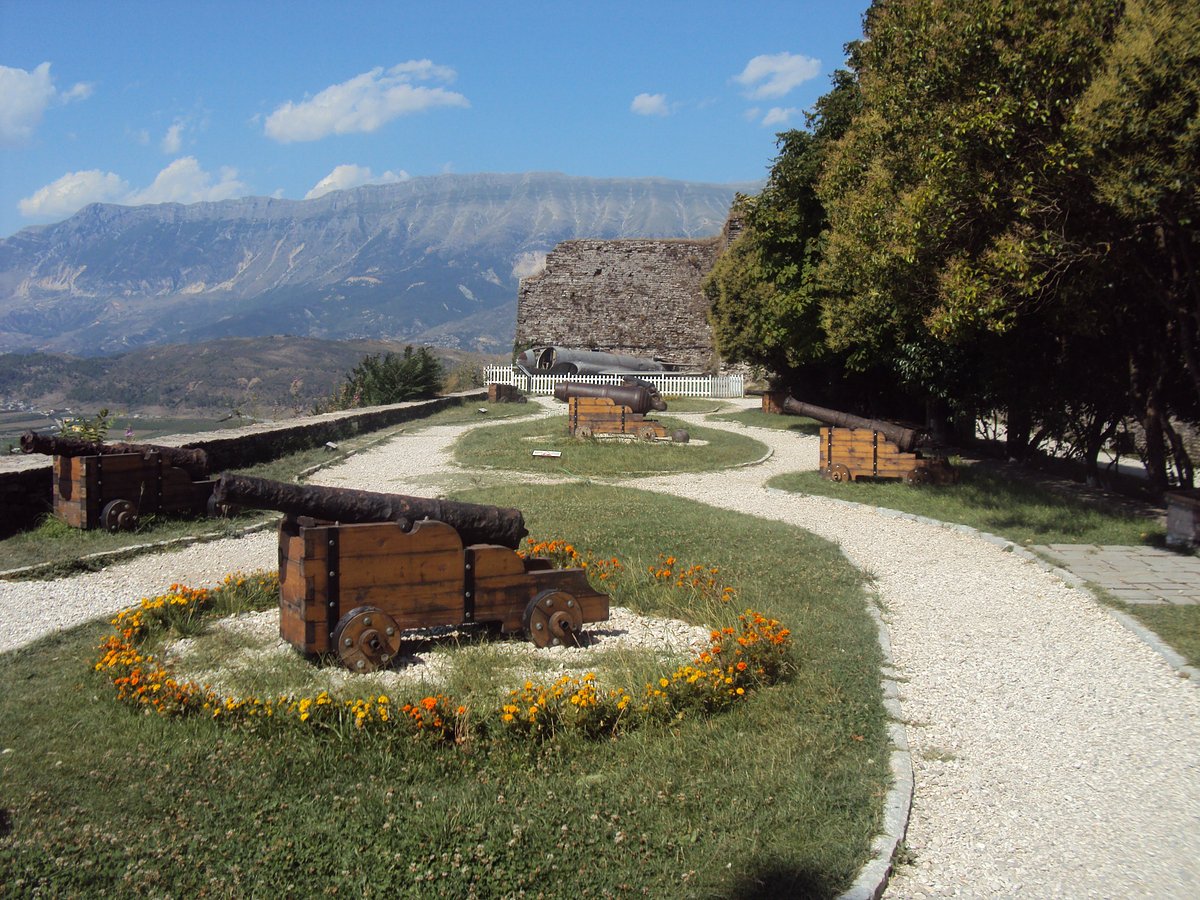
To ensure a memorable and smooth trip to Gjirokastër, keep these points in mind:
Weather: Gjirokastër has a Mediterranean climate.
Summer (June - August): Very hot, temperatures can be high. Prepare light clothing, a hat, sunscreen, and drink plenty of water. This is also the peak tourist season.
Spring (April - May) and Autumn (September - October): The most pleasant weather, ideal for sightseeing and walking. The landscapes are also very beautiful during these seasons.
Winter (November - March): Can be cold and rainy. Some tourist services might be limited.
Comfortable footwear: Due to the city's characteristic steep terrain and slippery cobblestone streets, wearing comfortable, good-grip walking shoes is extremely important.
Mobile reception and Internet: Most central areas and hotels have good mobile reception and Wi-Fi. However, when traveling to rural areas or more distant spots, reception might be weak. You can purchase a local SIM card for convenient communication.
Sustainable travel: Gjirokastër is a precious heritage. Be a responsible traveler: do not litter, respect historical sites, do not damage public or private property. When shopping, prioritize local handicrafts to support the community.
Photography: Gjirokastër is a photographer's paradise. Prepare your camera, extra batteries, and a large-capacity memory card. You'll want to capture every street corner, every stone house, and the majestic views from the castle.
Interacting with locals: Albanians are known for their friendliness and hospitality. Most young people and those working in tourism can speak English. Learning a few basic Albanian phrases like "Përshëndetje" (Hello) or "Faleminderit" (Thank you) will be very helpful and help you connect more easily.
Explore lesser-known spots: Besides the main attractions, Gjirokastër has many interesting alleys, small cafes, and hidden gems waiting for you to discover. Don't be afraid to stray from the main path to find pleasant surprises.
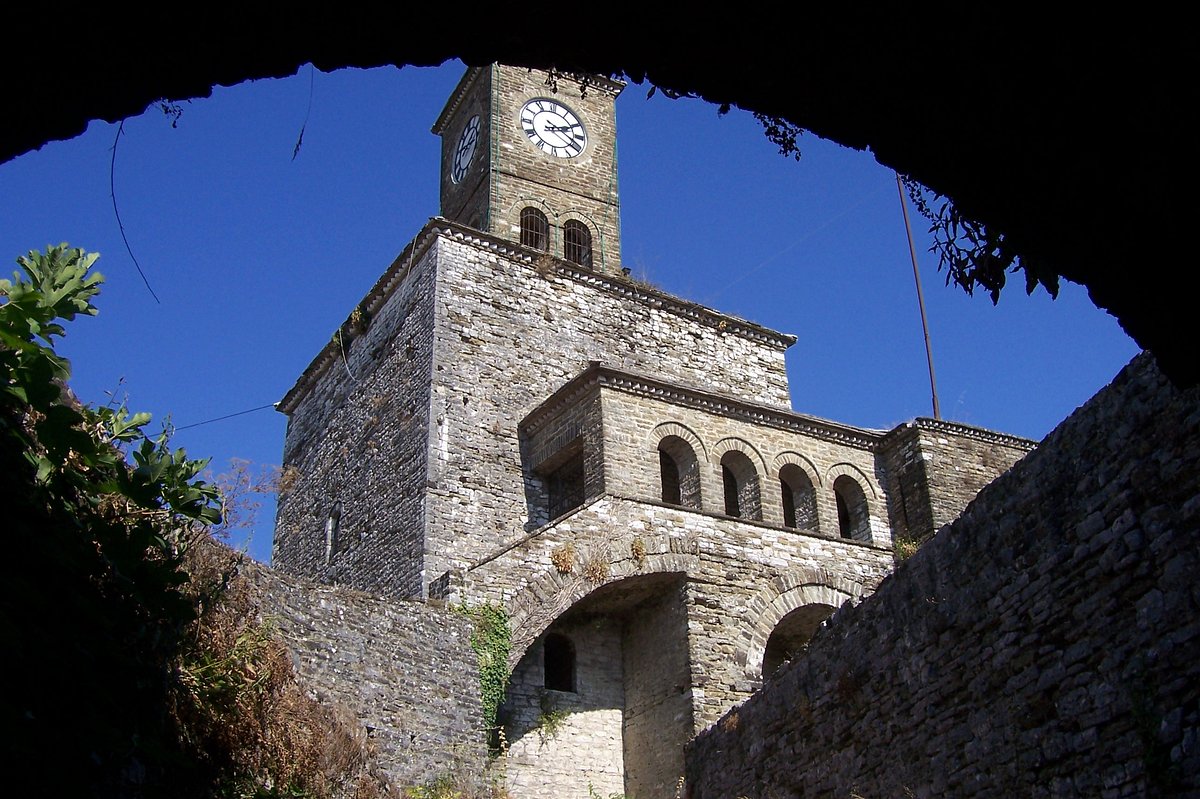
Gjirokastër is more than just a city; it is a vibrant experience, a door opening to Albania's glorious past. From its ancient fortress to its unique stone houses with slate roofs, from its historic cobblestone streets to its traditional culinary flavors, every corner of Gjirokastër tells its own story. This place attracts not only architecture and history lovers but also those seeking tranquility, authentic beauty, and warm hospitality.
Prepare to immerse yourself in the captivating beauty of this "Stone City," to listen to the whispers of the wind over ancient roofs, and to feel the pulse of a culture that continues to thrive. Gjirokastër awaits your exploration, promising an unforgettable adventure, a memory that will stay with you forever.
Are you ready to write your own story in Gjirokastër?